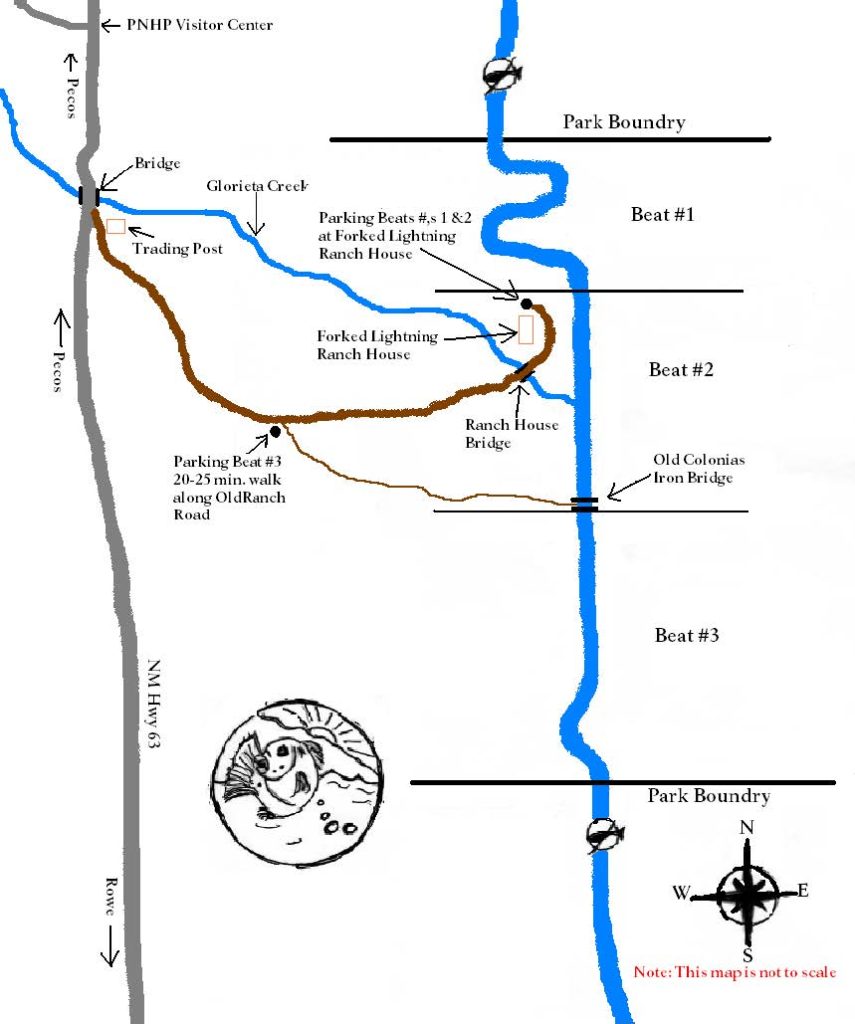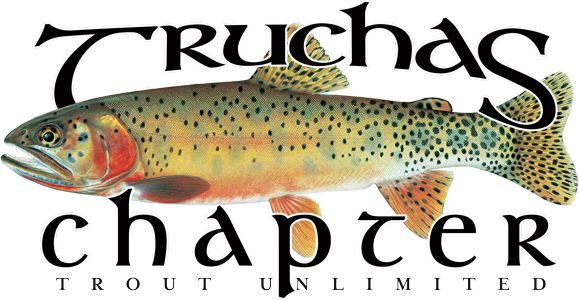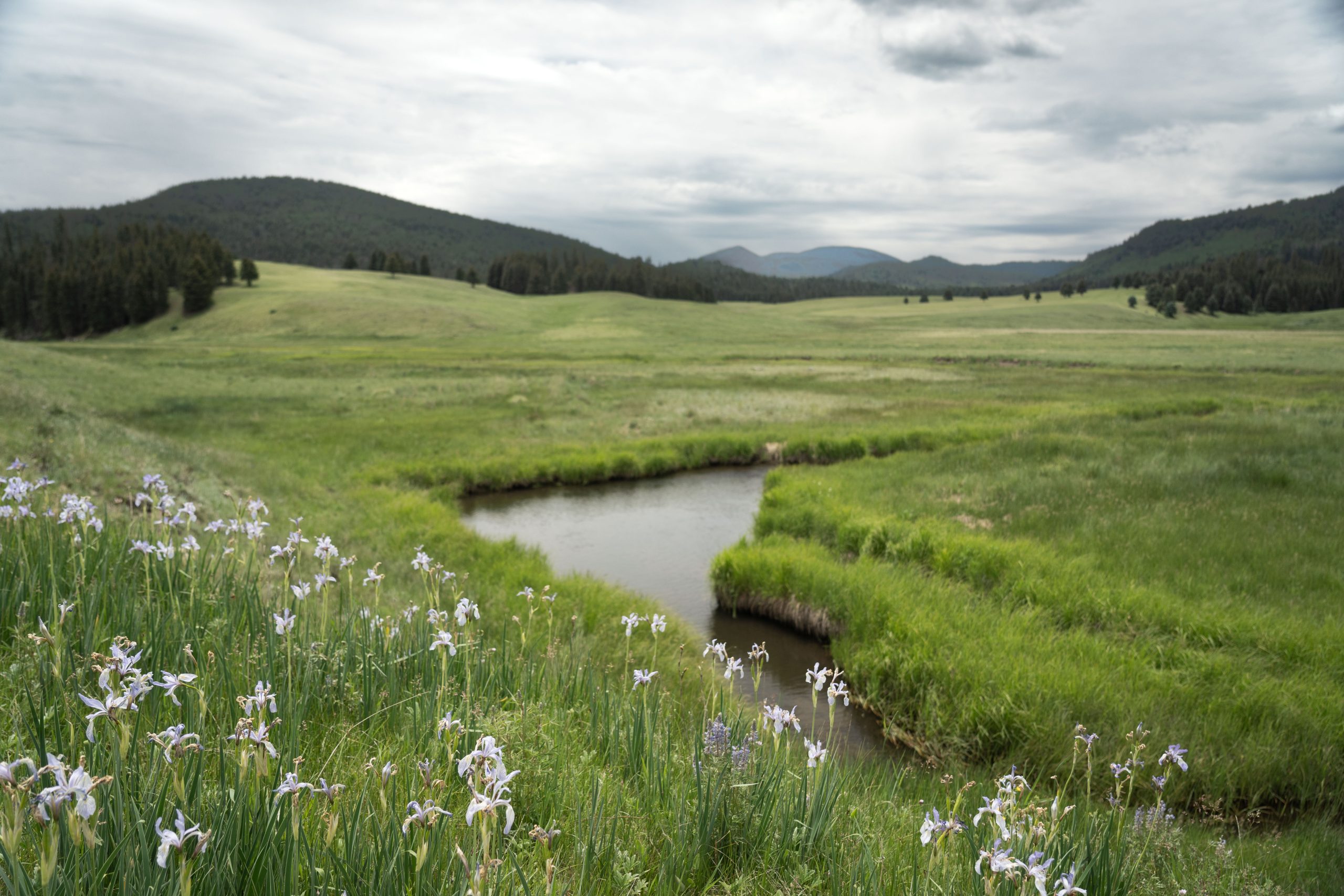The lower mile (Beat 3) of river flows through more open country, gliding past grassy banks, willow thickets, and cottonwood stands, ending in a pool against a cliff wall. Fossils are visible in limestone outcrops along the river near the old railroad bridge and many different birds can be seen in this nearly pristine riparian area. Brown trout and rainbow trout can be caught with typical trout stream patterns, and anglers may enjoy a sense of wilderness and natural grandeur on the river inside the boundaries of Pecos NHP.
The Pecos River begins in the Santa Fe National Forest and heads south. After flowing through the village of Pecos and private ranch land, the river enters Pecos National Historical Park (Pecos NHP), where it winds for three miles. Each mile has been designated as its own fishing beat in the park. The upper two miles (Beats 1 and 2) form a beautiful stretch of river shaded by pines and bordered by grassy banks intermixed with stands of willows. The river curves against rock walls, forming deep pools interspersed with riffles and boulder-studded runs. There is excellent trout habitat, and the gravel substrate supports abundant invertebrates.
Native fish in this section of the Pecos River include longnose dace (Rhinichthys cataractae), white suckers (Catostomus commersonii), and the Rio Grande chub (Gila pandora).
While Rio Grande cutthroat trout (Oncorhynchus clarkii) are found in the headwaters of the Pecos River and likely were once present in this lower stretch of river, they are rarely seen within the park.
Non-native brown trout and rainbow trout are some of the most common fish in the river today. These trout consistently outcompete and prey on other species, leading to declining populations of native fish.
Anglers are encouraged to keep brown and rainbow trout, in accordance with state bag limits. When caught, all native fish must be immediately and carefully returned alive and unharmed to the water from which they were caught.
Note that a reservation only guarantees a spot on the beat for the day. All groups must check in at the visitor center before heading to the beat, and must check out at the end of the day, before the visitor center closes.
Due to limited parking at the beats, a maximum of two vehicles is allowed per reservation. When possible, groups are strongly encouraged to carpool in a single vehicle from their original location or from the visitor center parking lot.
Reservations are required and may only only be obtained through recreation.gov or by calling 1-877-444-6777. Park staff are not able to make, change, or cancel reservations.
Reservations cost $1 (non-refundable), and may be made no more than 30 days in advance. A single reservation allows for a group of up to four people to fish anywhere along the designated beat during set hours (8:30am to 3pm) that day. Beats 1 and 2 begin only a few hundred yards from the parking area; accessing Beat 3 requires an approximately one-mile hike.
Anglers at Pecos NHP must show a valid New Mexico state fishing license at check-in. There are no registered license vendors in Pecos, and Wi-Fi connection at the visitor center can be spotty. Anglers should therefore purchase licenses before arriving at the park. Licenses can be purchased online, by phone (888-248-6866), or in person at license vendors.
For state requirements, to purchase licenses online, or to find a list of registered vendors, visit: www.wildlife.state.nm.us/fishing
- Free Licenses are available for New Mexico resident anglers 70 years of age and older.
- Licenses are not required for anglers under 12 years of age.
- Junior Fishing Licenses are available for anglers 12–17 years of age.
- Senior Fishing Licenses are available for New Mexico resident anglers 65–69 years of age.
During an emergency, please dial 911.
Terrain: There are no formal trails. Anglers should be prepared to navigate rough and uneven terrain and thick stands of willows.
Wildlife: The Pecos River corridor is home to abundant wildlife, including rattlesnakes and black bears. Anglers should use caution when walking through spots with low visibility.
Weather: If lightning occurs close to the river, anglers should proceed immediately to shelter. During monsoon season (typically July – September), the Pecos River may have high flow rates or even flash flood. Anglers should stay aware of river flow rates.
Bathrooms: Portable toilets are available at the parking areas for each beat during fishing season.
Sun Protection: Hats, sunscreen, and water are strongly recommended. Anglers should bring enough water for the full day of fishing.
Anglers are responsible for their own safety, and should pay close attention to weather reports, river flow rates, and changing conditions throughout the day.

Fishing at Pecos NHP is managed in accordance with NPS general regulations, special park regulations, the Superintendent’s Compendium, and state regulations. Where state and federal regulations conflict, federal regulations take precedence. It is anglers’ responsibility to be aware of all relevant regulations. Some key regulations at Pecos NHP include:
- Angling is only permitted during the park’s fishing season (set annually; typically summer and fall), and reservations are required.
- All anglers must possess a valid New Mexico state fishing license and show this license at check-in.
- The use or possession of all live or dead organic baits (e.g. worms, grasshoppers, corn, etc.) or scented attractants is prohibited.
- Only one, artificial lure with a single hook may be used on a single rod.
- Up to two flies maybe used on a single leader; flies may only have one single-point, barbless hook.
- All native fish must be released immediately; non-native fish, such as rainbow and brown trout, may be kept in accordance with state bag limits.
- No pets are permitted on the river; only service animals are permitted.
- Anglers must pack out all trash.
- No commercial guiding allowed.
- No open fires are allowed.
- Smoking is prohibited along the river. • Anglers are only permitted on the designated roadways and along the riverbanks; general access to the backcountry is prohibited.
This is not a comprehensive list of park regulations; anglers should review all relevant NPS, park, and state regulations before fishing.

